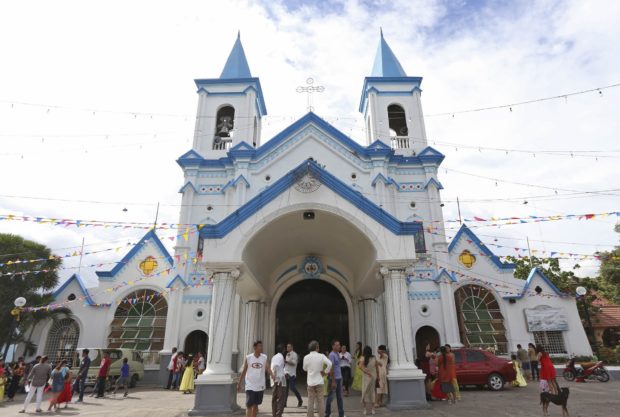
ONE OF THE FAVORITES Sacred Heart of Mary Parish Church in Minglanilla, Cebu province. —JUNJIE MENDOZA
CEBU CITY — These holy days see the faithful going from one church to another.
In keeping with the Catholic tradition, many Cebuanos hold a Visita Iglesia or church visit on the night of Maundy Thursday to commemorate Jesus’ agony in the Garden of Gethsemane and his subsequent arrest.
They visit and pray at seven churches (at least), a practice introduced by the Spanish colonizers 450 years ago. The tradition was primarily intended as a means to honor the Blessed Sacrament, which is placed on the Altar of Repose on Maundy Thursday.
Pilgrimage
There are a number of churches in Cebu, but seven churches in the south are considered favorites by those who practice the Visita Iglesia.
The pilgrimage starts in Talisay City and ends in the town of Sibonga, 53 kilometers from Cebu City.
The first stop is the Santa Teresa de Avila Parish Church in Talisay, the gateway to southern Cebu. The construction of the church began in 1836 and was finished in 1848. Made of finely cut coral stones, the church was originally cruciform with one main nave and short, semiround transepts.
After it was badly damaged during World War II, the church was restored in 1950 with a Graeco-Roman design.
Twin massive bell towers capped with red domes flank the facade. The interiors, especially the presbytery and the transepts, are heavily embellished. There are a total of five altars, including the main one, each gilded and holding a statue of a particular devotion.
The next stop is the Sacred Heart of Mary Parish Church in the adjacent town of Minglanilla. The church, colored pink, sits on an elevated plain that overlooks the town square.
It is a contemporary cruciform structure of concrete with twin bell towers dating back to the prewar period. The paired belfries are a later addition.
The church was expanded on both sides through the years. Much of the interiors are contemporary. Windows with stained-glass depictions of the Blessed Virgin Mary adorn the left and right transepts.
From Minglanilla, the faithful proceed to the San Francisco de Asis Parish Church in Naga City.
The church became independent on June 12, 1829, under the advocacy of San Francisco de Asis. As in the Sacred Heart of Mary Church , there are one main and four side altars, each with a statue of a particular devotion.
The main altar is a large neoclassical structure with a canopy and the statue of San Francisco de Asis embracing the Crucified Christ. Each of the two side altars has a tabernacle.
Century-old church
From Naga, the next stop is the town of San Fernando and its century-old San Isidro Labrador Parish Church.
The church was established by diocesan decree on Jan. 19, 1858, with San Isidro Labrador as patron saint.
The interior is basically contemporary, a product of renovation carried out by Msgr. Constantino Batocoy in 1972, except for two large windows at the end of the nave that retain their Gothic character.
The church’s two-story convent, which retains much of its coral-stone character on the ground floor, was converted in 1945 into the Notre Dame College, which still exist.
The pilgrimage continues to the Santa Catherine de Alexandria Church in Carcar City.
The church, of the Graeco-Roman design, is an elongated rectangular structure with a main nave and two side aisles.
Horizontal lines divide the facade into various segments. The topmost part contains the pediment and the twin bell towers that are capped with onion-type domes resembling those of religious buildings in Eastern Europe. A massive recessed arch occupies almost two-thirds of the height of the facade and resembles the iwan of the Middle Eastern mosques.
Last stop
The last stop is Sibonga, where two churches are worth the visit.
The Nuestra Señora del Pilar Church at Barangay Poblacion was the town’s first church. It was originally built with light materials because it was supposed to be temporary. It was replaced with the present structure in the 1980s, its edifice built with coral stone.
Twin towers flank the main entrance. The arch of the church portal is Gothic, pulling the eyes upward despite the somewhat stolid look of the bell towers whose lower-level, semi-Gothic windows are covered with decorative cement blocks.
The pediment above this arch has a rose window, which is typical of Gothic architecture.
The other church is the Our Lady of Lindogon Shrine in Barangay Simala, which is perched atop a hill with a spectacular view of the mountain.
A popular destination in the south, the castle-like church has become a refuge, with many devotees claiming to have experienced miracles from God through the intercession of the Blessed Virgin Mary.
Not a tourism activity
As the faithful prepare for the Visita Iglesia, Fr. Brian Brigoli, chair of the Cebu Archdiocesan Commission on Culture Heritage, has a word of advice.
“This is not a tourism activity. We don’t go to churches to simply stroll around. We do Visita Iglesia to pray,” Brigoli told the Inquirer. “This is a form of spiritual exercise, a part of sacrifice and mortification. When we go to the churches, we must have in mind the intention to pray.”
In the San Carlos Seminary College where Brigoli served as professor, he said they organized what they called “Bisikleta Iglesia,” in which the pilgrimage is conducted by biking on a route covering the seven churches.